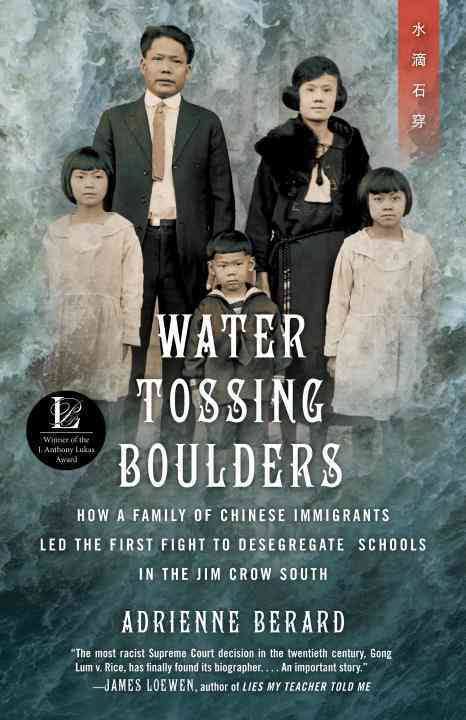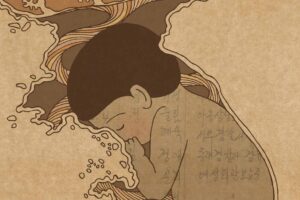By Stan Lou
OCA – Asian Pacific American Advocates
January 9, 2017
Some of you may know that I read and follow Chinese and Asian American literature faithfully and have written several book reviews. I am also an American Born Chinese (ABC) who grew up in Mississippi during the Jim Crow era when racial segregation was rampant in the South. Consequently, the book, Water Tossing Boulders, written by Adrienne Berard, became a “must-read” book for me. This is a documentation of the story of Chinese immigrants leading a fight to desegregate a school in Mississippi in the 1920s.
The subject of this book caught my attention immediately, as many of us in the APA community are aware of the Gong Lum vs. Rice case and know that this story has been ignored or purposely hidden, as many of the stories of Chinese American history have been. Our history has not been covered fairly or correctly as Chinese have always been a part of American history. Our stories need to be told and understood, and this story is one that certainly bears being shared. Before reading this book, I had doubts about how an “outsider” to Mississippi and to the APA community could accurately portray the events of this story. Although I still believe that our history is best told through our own voices and not through outsiders, I found Water Tossing Boulders to be well written, thoroughly researched, and accurate in its portrayal of Mississippi life. As the author noted in her notes, she embedded herself in the Mississippi community for fifteen months to learn and understand many of the nuances of life in this environment that still reflects many of the characteristics of the time of the book’s story.
In the fall of 1924, the Lum family was told by the Rosedale school that the two girls in the family who had been attending the school in prior years could no longer attend this school which was for whites only because the family was “colored.” The decision of the Lum family to fight this order forms the substance of this documentary. This could have been done by simply relaying the facts of the law suit and following its trail through the State Supreme Court and ultimately to the United State Supreme Court, where it met its fate that confirmed that the State of Mississippi could indeed exclude “colored” students from white-only schools. This ordeal has enough substance to be an impelling tale. However, Ms. Berard chose to relate the story to include very important descriptions of the background and backdrop of the social environment during this time and how it came to this attitude, not only in the State, but also in Washington and other parts of the country. It is important to know the prevailing line of thinking that the non-Asian (white) population owned and how it was developed.
Again, most of the APA community is aware of the historical persecution of Chinese that developed in the late 1800s and continued beyond. However, many non-Asians do not know this history. The author delves into events that heightened the “Chinese Must Go” attitude and generated intolerance for the Chinese community. She describes how members of Congress spoke of these people as objects instead of human beings. She includes other seemingly unrelated events, but which in fact had profound influences that were occurring in the country at this time. She gives vivid details of the family histories of players who would take part in the Gong Lum story. Her writing demonstrated that all of these events led to the 1927 Supreme Court decision to affirm racial segregation in public schools. Adrienne Barard did an exceptional job in weaving together of all these events and characters to show their relevance to the bigger picture of the Gong Lum law suit, i.e. it was much more than just a fight for one family to be permitted to attend a white school in Rosedale, Mississippi. This bigger picture included how it all related to the historic 1954 Supreme Court decision to officially end school segregation. To me, this was one of the strongest aspects of the book.
In her presentations of the essential players, the details let us know more of the characters and their personalities. In particular, she presents a thorough picture of Earl Brewer, the man who became the lawyer of the Lums, to the point that we understand him quite well. Perhaps, we know his nature better than the Lums! That is one area that disappointed me in this book. It did not let me get to know the family in a personal way as I feel that I got to know Earl Brewer and his family. It would have been good to know more of the human side of the family and their true motivations for taking on this fight. On that point, I feel a bit empty. What the Lums did was indeed courageous, but did they undertake this for the good of all the Delta Chinese? If so, why was the other family of the two other Chinese girls in Rosedale not included? Did they have the support of other Delta Chinese American families? Perhaps this perspective could not be determined accurately enough to include. As the author alluded to in her notes, this was a “hidden story.” Consequently, I am sure that people who may have known more details choose to remain reticent. The Lum children were very young at the time, and probably did not discuss these events in great depth with their parents. This is said to be a trait of Chinese families.
Despite this rather minor disappointment, Water Tossing Boulders is an excellently written book, and I liked it very much. I commend Adrienne Berard for authoring it. I recommend that we all, the APA community and the mainstream American public, support this book and the important story it tells of the Chinese American profound involvement in American history.
The 1882 Foundation’s Talk Story Series hosted author Adrienne Berard on September 5, 2017. Check out the recap of that event here.




